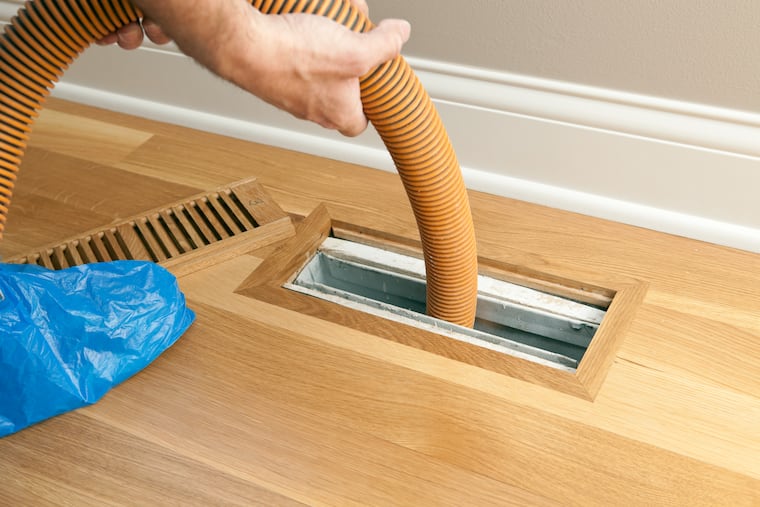Considering having your home’s air ducts cleaned? Don’t.
Even if your ducts are very dirty, cleaning them likely won’t lower dust levels throughout your home.

Maintaining clean air ducts in your home probably seems like something you should do. But although air ducts do get dirty, air-quality experts consistently agree that ductwork cleanings provide no measurable benefit, even if residents suffer from allergies or asthma.
Even if your ducts are very dirty, cleaning them likely won’t lower dust levels throughout your home. Dust that settles in your ventilation system generally stays put, unlikely to become airborne unless disturbed. Under most circumstances, having it removed provides little benefit and may create a bigger problem.
How duct cleaners work
To clean ducts, a company places the system under negative pressure — essentially connecting a very large, powerful vacuum cleaner to one or more openings in the ductwork and sucking out loose dust and other debris. Because a vacuum isn’t powerful enough to loosen and remove all particles, duct cleaners must agitate the dust inside the ducts using brushes and compressed air nozzles.
Duct-cleaning companies may also clean the heating and cooling equipment (heat exchangers, cooling coils, condensate drain pans, fan motors, fan blades, and fan housings), but these tasks aren’t always included as part of their basic service. Consider having a good HVAC contractor do that work every few years, or when you need repairs. Until March 5, Inquirer readers can access nonprofit Delaware Valley Consumers’ Checkbook’s unbiased ratings of local HVAC companies, and all its other ratings and advice, via Checkbook.org/Inquirer/Ducts.
Why you don’t need it
Although duct-cleaning operations may insist their services are essential for your health, the evidence doesn’t support their claims.
Dust that settles in your ventilation system generally stays where it is. Unless disturbed, it remains inert and harmless.
Unfortunately, many duct cleaning companies mislead their customers by promoting health benefits and using language in ads like, “Studies have shown …” But no independent data back up these claims.
Air-quality experts don’t recommend regular duct cleanings. The official advisory of the U.S. Environmental Protection Agency (EPA) concludes:
Little research has been done on duct cleaning’s effects. One of the only independent studies was in the 1990s by the Canada Mortgage and Housing Corporation (CMHC), when it tested 33 homes in Montreal before and after duct cleaning. It found no significant improvement in air quality, and duct cleaning alone did not improve airflow or energy efficiency. In some cases, measured particle levels increased immediately after a cleaning. In other cases, particle levels decreased immediately after cleaning, but returned to previous levels within weeks.
If you have special concerns about mold
If you suspect a mold problem, know that cleaning ducts won’t do much good. Mold always begins with a moisture problem, and the ducts themselves are unlikely to be the source of the problem. The most likely culprits are the cooling system’s evaporator coils, which an HVAC contractor can inspect and maintain. Leaky return ducts can also introduce moisture.
Cleaners might damage your ducts
If the vacuum pressure isn’t applied carefully, some of the dust that settled in the ducts will be loosened by the agitation and blown into the living space after the cleaning. (This explains the results of the Canadian study in which particle levels rose immediately after a cleaning.)
Many homes now have flexible coil-style ducts — the kind that look like a Slinky — which are vulnerable to being punctured by duct cleaning work. Most forced-air systems are designed as closed loops, and leaks in the return-air circuit allow unfiltered air to be sucked from basements or attics, bringing with it dust and moisture.
Ductwork fabricated from fiberglass-insulated material has also become more common in new homes. These ducts have fiberglass insulation on their interior surfaces. The fiberglass surface is sealed, but if a duct-cleaning company is not careful, the cleaning can damage the insulation, loosening fibers that can become airborne.
How to control dust
Establish regular cleaning routines. Change your HVAC system air filter four to six times a year. Keep humidity levels below 50%. Keep windows closed during peak pollen times or during times of high outdoor pollution. Visit AAFA.org for more tips.
When to hire a duct cleaner
In general, consider duct cleaning only in response to specific identifiable problems. The EPA suggests doing it only if there is visible evidence of:
Substantial mold growth
Infestation of insects or rodents
Substantial deposits of dust or debris (if registers were not sealed during a renovation project, for example)
But the EPA also notes that hiring a duct cleaner to resolve one of these problems isn’t a permanent solution: “If any of the conditions above exists, it usually suggests one or more underlying causes. Prior to any cleaning, retrofitting, or replacing of your ducts, the cause or causes must be corrected or else the problem will likely recur.”
Delaware Valley Consumers’ Checkbook magazine and Checkbook.org is a nonprofit organization with a mission to help consumers get the best service and lowest prices. We are supported by consumers and take no money from the service providers we evaluate.